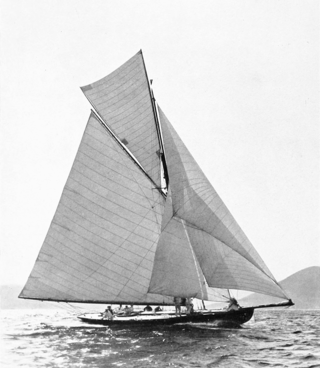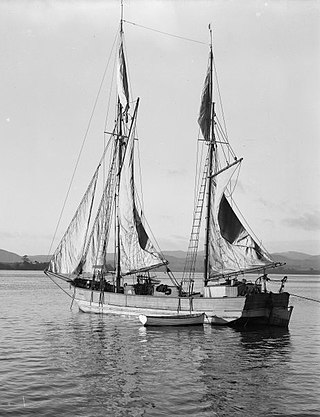


The Friendship sloop, also known as a Muscongus Bay sloop or lobster sloop, is a gaff-rigged working boat design that originated in Friendship, Maine around 1880 and has survived as a traditional-style sailboat.



The Friendship sloop, also known as a Muscongus Bay sloop or lobster sloop, is a gaff-rigged working boat design that originated in Friendship, Maine around 1880 and has survived as a traditional-style sailboat.
Fishermen in Friendship and neighboring Bremen collectively originated the boat's design, influenced in part, by the fishing sailboats of Gloucester, Massachusetts. [1] The boat was used primarily for lobstering or local commerce. [2] Boat builder Wilbur A. Morse was principle among five major Muscongus Bay builders [3] that produced the design from the 1880s to the 1910s. [4] From then until 1960 four major builders continued the tradition, three from the region. [3]
One person could manage its single-masted rig and haul traps unassisted, yet the boat could carry sizable loads. With an open cockpit aft, and a small forward cabin outfitted with bunks and a stove, it made fishing during cold weather much less arduous than in an open boat. By 1900 these sloops ranged from 30–40 feet (9.1–12.2 m) feet long along the deck and were used for bringing fish or lobsters from offshore vessels to processing plants. [3]
In the 1900s the boats received auxiliary motors until 1920, when power boats supplanted them for commercial use. Thereafter, the fleet became available to those who adapted boats to become affordable sailing yachts. [3]
Modern reproductions, both wooden and fiberglass, continue to be built. although the cockpits and interiors of such pleasure craft tend to be substantially different from the original workboats. The overall design and historical example of the type are preserved through the Friendship Sloop Society. [5] The society holds annual races in Maine. [6]
Friendship sloops typically have a clipper bow, a full keel, an elliptical stern and a bowsprit. The mast height is approximately equal to the length of the deck and stepped forward, such that the head sails are attached to the bowsprit. The hull typically has a full length keel, traditionally ballasted with rocks or more recently with steel. [1] They are gaff-rigged, with a mainsail, a staysail and normally a jib. They may additionally have a topmast with a main topsail and jib topsail (flying jib). They have ranged from 19–50 feet (5.8–15.2 m) feet along the deck; plans are available for such vessels up to 40 feet (12.2 m) along the deck. [3]
The Friendship Sloop Society initially classified the boats, as follows: [3]
In 1986, it combined classes B through D. The boats recognized as "one of a kind" outnumber those regarded as "semi-production". Races are held in two divisions for boats 25 feet (7.6 m) or shorter on the deck (Division I) and those longer than that (Division II). [3]

A sloop is a sailboat with a single mast typically having only one headsail in front of the mast and one mainsail aft of (behind) the mast. Such an arrangement is called a fore-and-aft rig, and can be rigged as a Bermuda rig with triangular sails fore and aft, or as a gaff-rig with triangular foresail(s) and a gaff rigged mainsail.

A schooner is a type of sailing vessel defined by its rig: fore-and-aft rigged on all of two or more masts and, in the case of a two-masted schooner, the foremast generally being shorter than the mainmast. A common variant, the topsail schooner also has a square topsail on the foremast, to which may be added a topgallant. Differing definitions leave uncertain whether the addition of a fore course would make such a vessel a brigantine. Many schooners are gaff-rigged, but other examples include Bermuda rig and the staysail schooner.

A sailboat or sailing boat is a boat propelled partly or entirely by sails and is smaller than a sailing ship. Distinctions in what constitutes a sailing boat and ship vary by region and maritime culture.

A sailing vessel's rig is its arrangement of masts, sails and rigging. Examples include a schooner rig, cutter rig, junk rig, etc. A rig may be broadly categorized as "fore-and-aft", "square", or a combination of both. Within the fore-and-aft category there is a variety of triangular and quadrilateral sail shapes. Spars or battens may be used to help shape a given kind of sail. Each rig may be described with a sail plan—formally, a drawing of a vessel, viewed from the side.

The Bermuda sloop is a historical type of fore-and-aft rigged single-masted sailing vessel developed on the islands of Bermuda in the 17th century. Such vessels originally had gaff rigs with quadrilateral sails, but evolved to use the Bermuda rig with triangular sails. Although the Bermuda sloop is often described as a development of the narrower-beamed Jamaica sloop, which dates from the 1670s, the high, raked masts and triangular sails of the Bermuda rig are rooted in a tradition of Bermudian boat design dating from the earliest decades of the 17th century. It is distinguished from other vessels with the triangular Bermuda rig, which may have multiple masts or may not have evolved in hull form from the traditional designs.

A catboat is a sailboat with a single sail on a single mast set well forward in the bow of a very beamy and (usually) shallow draft hull. Typically they are gaff rigged, though Bermuda rig is also used. Most are fitted with a centreboard, although some have a keel. The hull can be 3.7 to 12.2 metres long with a beam half as wide as the hull length at the waterline. The type is mainly found on that part of the Eastern seaboard of the USA from New Jersey to Massachusetts.

A scow is a smaller type of barge. Some scows are rigged as sailing scows. In the 19th and early 20th centuries, scows carried cargo in coastal waters and inland waterways, having an advantage for navigating shallow water or small harbours. Scows were in common use in the American Great Lakes and other parts of the U.S., Canada, southern England, and New Zealand. In modern times their main purpose is for recreation and racing; there are also garbage scows for aquatic transport of refuse.

A tall ship is a large, traditionally-rigged sailing vessel. Popular modern tall ship rigs include topsail schooners, brigantines, brigs and barques. "Tall ship" can also be defined more specifically by an organization, such as for a race or festival.

A cutter is a name for various types of watercraft. It can apply to the rig of a sailing vessel, to a governmental enforcement agency vessel, to a type of ship's boat which can be used under sail or oars, or, historically, to a type of fast-sailing vessel introduced in the 18th century, some of which were used as small warships.

Gaff rig is a sailing rig in which the sail is four-cornered, fore-and-aft rigged, controlled at its peak and, usually, its entire head by a spar (pole) called the gaff. Because of the size and shape of the sail, a gaff rig will have running backstays rather than permanent backstays.

A Bermuda rig, Bermudian rig, or Marconi rig is a configuration of mast and rigging for a type of sailboat and is the typical configuration for most modern sailboats. This configuration was developed in Bermuda in the 17th century; the term Marconi, a reference to the inventor of the radio, Guglielmo Marconi, became associated with this configuration in the early 20th century, because the wires that stabilize the mast of a Bermuda rig reminded observers of the wires on early radio masts.

A Thames sailing barge is a type of commercial sailing boat once common on the River Thames in London. The flat-bottomed barges, with a shallow draught and leeboards, were perfectly adapted to the Thames Estuary, with its shallow waters and narrow tributary rivers. The larger barges were seaworthy vessels, and were the largest sailing vessel to be handled by just two men. The average size was about 120 tons and they carried 4,200 square feet (390 m2) of canvas sail in six working sails. The mainsail was loose-footed and set up with a sprit, and was brailed to the mast when not needed. It is sheeted to a horse, as is the foresail; they require no attention when tacking. The foresail is often held back by the mate to help the vessel come about more swiftly.

A fractional rig on a sailing vessel consists of a foresail, such as a jib or genoa sail, that does not reach all the way to the top of the mast.

The log canoe is a type of sailboat developed in the Chesapeake Bay region. Based on the dugout, it was the principal traditional fishing boat of the bay until superseded by the bugeye and the skipjack. However, it is most famous as a racing sailboat, and races continue to be held.

The Front Runner is a small day sailing dinghy. It is a high-performance, responsive, and comfortable one-design class sailboat. It is stable and user-friendly, having an immense cockpit with all control lines leading aft. While designed for racing, it also functions as a small cruising day sailer because of the storage space under the deck in the bow.

The nobby is an inshore sailing boat which was used as a traditional fishing boat around Lancashire and the Isle of Man. The Lancashire nobby originated in Morecambe Bay about 1840 and around Southport. It subsequently came into widespread use down the north west coast of England. The Manx nobby first appeared in the 1880s and was used around the Isle of Man. Many localities on the coast of Great Britain developed their own type of fishing boat adapted to local fishing and sea conditions, and the nobbies are examples of this.
The following outline is provided as an overview of and topical guide to sailing:
The Cornish Crabber 24 is a series of British trailerable sailboats, designed by Roger Dongray as cruisers and first built in 1974.
The Herreshoff Eagle, also called the Herreshoff Eagle 21, is an American trailerable sailboat that was designed by Halsey Chase Herreshoff as a cruiser and first built in 1976.
The Menger Oysterman 23 is an American trailerable skipjack that was designed by Bill Menger as a daysailer and cruiser and first built in 1977.